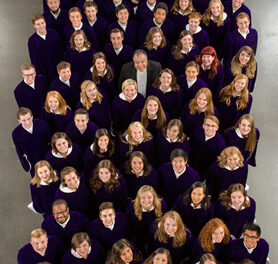A large audience was on hand in Ernest Nelson Music Room, a perfect acoustical jewel in the East Duke Building, on the East Campus of Duke University, for the second of this season’s regular Ciompi Quartet concerts, presented by Duke Performances. A very imaginative program combined two beloved works by Mozart and Schubert, sandwiched around a recent work by a composer with multiple local ties. The guest instrumentalists were double bass player John Brown, currently Director of the Jazz Program and an associate Professor of music at Duke, who joined the quartet for a treasured Mozart work, and cellist and Durham native Thomas Kraines, a former member of the Peabody Piano Trio and currently active as an instrumentalist, composer, and teacher, who added his expertise to the monumental Schubert Cello Quintet.
The Serenade in G for Strings, Eine Kleine Nachtmusik, K.525, by Wolfgang Amadeus Mozart, is one of most easily recognized pieces of music you really have not encountered so often. It is more often heard in performances by chamber orchestras of varying size. Its familiar tunes were widely used, even abused, in radio broadcasts, advertisements, and movies during WWII and the Baby Boom generation. As cellist Fred Raimi’s fine program notes recount, K.525 is rarely played by string quartets. A Philips recording of all the Mozart String Quartets by Quartetto Italiano is the only one I can recall. Most of the composer’s serenades have far more than K.525’s four movements. The Ciompi Quartet played immaculately, with crisp articulation and lively rhythms. The solid bass underpinnings by Brown contributed a great deal to the expressiveness of this performance.
Composer David Lipten (b.1961) received his Ph.D. in composition from Duke University, where he studied with Steven Jaffe and Scott Lindroth. Among the universities where he has taught is UNC-Chapel Hill. First violinist Eric Pritchard introduced the composer, who gave a few brief comments about his “Ictus” for String Quartet (2000). I missed his quip answer to those who ask “what does ictus mean.” The American Heritage Dictionary, Second College Edition defines “ictus,” used in pathology, as “a sudden attack.” Online sources define it as “a word for a stress or beat in a foot of poetry.” Lipten described his use as analogous to “accents in a poem” or a “recurring trophe” suggestive of a melody. He said this performance was a dress rehearsal for a recording of “Ictus” by the Ciompi Quartet. “Ictus” was commissioned by the Fromm Music Foundation of Harvard University in 1999, composed in 2000, and premiered in 2001 by the Chester String Quartet.
Nicolas Slonimsky’s Lexicon of Musical Invective, a treasure-trove to which I hope to avoid contributing, is filled with hilarious, wrong-headed and nasty barbs about composers and their works written by contemporaneous critics. Judging a new work on first hearing alone is very difficult, and getting a hook on recurring patterns is tricky. Lipten’s work makes imaginative use of a wide variety of string techniques, bounced bows, eerie high harmonics, snippets of melodic elements, wide dynamic ranges, and a plethora of color. At times each player is “off on his own” while two or more coalesce on the same part. “Ictus” does not overstay its welcome and is sufficiently inventive to make one want to give it another hearing. The Ciompi Quartet’s recording will be part of six chamber works and a choral work on the Ablaze Recording label.
The String Quintet in C, D.956 (1828), by Franz Schubert is indisputably one of the greatest chamber music works. The composer’s extraordinary ability to create and spin out seemingly endless melodies is everywhere evident. All five players’ virtuosity is challenged throughout the work’s four movements. The second movement, a slow, almost timeless adagio, is sublime, with extraordinary scoring for the pair of cellos. Raimi’s program note for this movement is especially cogent and succinct. Over the decades, the Ciompi Quartet, with changing rosters and guest cellists, has turned in many fine performances of this masterpiece, and this was no exception. The blending and contrasting of the cellos of Raimi and Kraines was gorgeous. Violinists Pritchard and Hsiao-mei Ku and violist Jonathan Bagg matched their give-and-take marvelously. Dynamics, tempos, and phrasing were well chosen and there was a fine sense of the overall structure of the piece.











